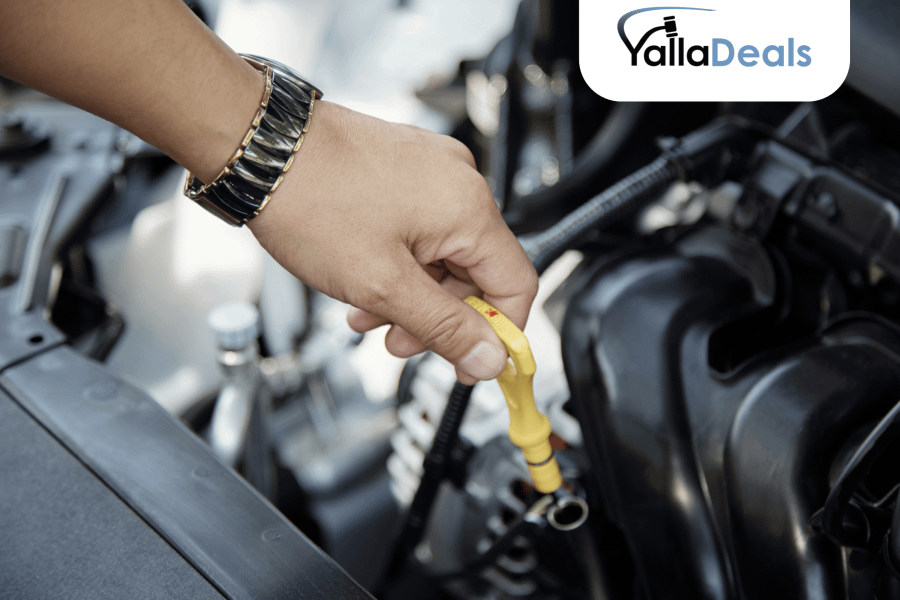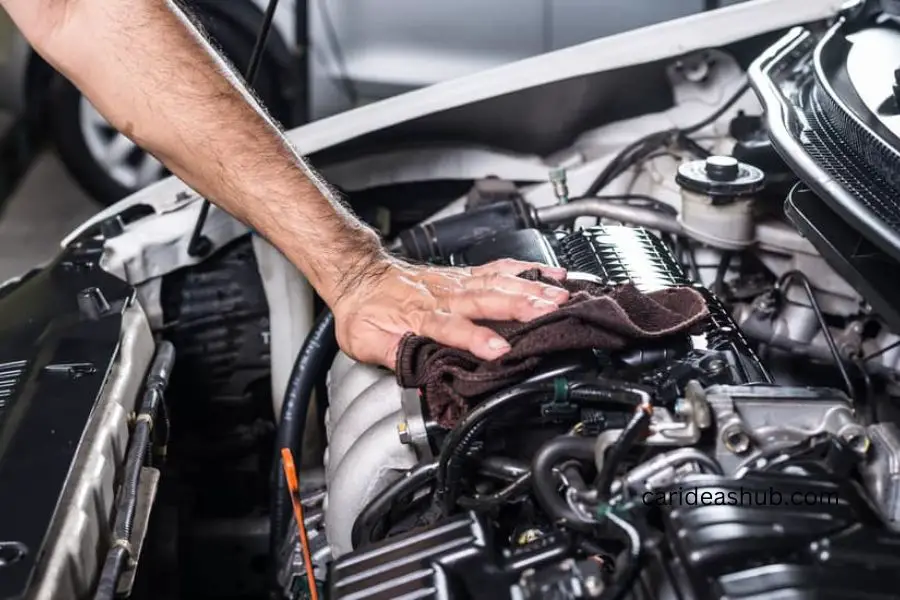If your engine maintenance required light is on, it indicates that your vehicle is due for servicing. Ignoring this warning could lead to serious mechanical issues.
Regular maintenance ensures your engine runs smoothly and reduces the risk of future breakdowns, enhancing the overall lifespan of your vehicle. Proper maintenance also contributes to fuel efficiency, saving you money in the long run. Taking your vehicle for regular engine maintenance not only ensures safety but also maintains the value of your investment.
It’s essential to address any engine maintenance required signals promptly to avoid costly repairs and keep your vehicle in peak condition. Regular maintenance can also detect potential issues early, preventing them from escalating into major problems.

The Importance Of Engine Maintenance
Performing regular engine maintenance is crucial to ensure the smooth running and longevity of your vehicle. Neglecting engine maintenance can lead to costly repairs and reduced fuel efficiency. By taking proper care of your engine, you can save money on repairs, improve fuel efficiency, and extend the lifespan of your vehicle.
Reducing Costly Repairs
Regular engine maintenance involves checking and replacing worn-out parts, such as spark plugs, filters, and belts, which can help prevent major breakdowns and costly repairs. By addressing small issues early, you can avoid larger, more expensive problems down the road.
Improving Fuel Efficiency
Proper engine maintenance, such as regular oil changes and tune-ups, can significantly improve fuel efficiency. Clean air filters, properly inflated tires, and well-maintained engine components all contribute to better gas mileage, saving you money at the pump.

Regularly Checking The Oil
Regularly checking the oil in your engine is a crucial part of engine maintenance. With proper and timely checks, you can ensure that your engine runs smoothly and efficiently.
It is essential to keep the oil levels at the optimum range to prevent any potential damage to the engine. In this section, we will discuss the importance of checking oil levels and changing the oil regularly as part of your engine maintenance routine.
Checking Oil Levels
To ensure the optimal performance of your engine, it is vital to regularly check the oil levels. Low oil levels can lead to increased friction and heat within the engine, which can cause severe damage. Here are the steps to check your oil levels:
- Run the engine for a few minutes to warm up the oil.
- Turn off the engine and wait for a few minutes to allow the oil to settle.
- Locate the oil dipstick and remove it from the engine.
- Wipe the dipstick clean and reinsert it into the engine.
- Remove the dipstick again and check the oil level. It should be between the minimum and maximum marks on the dipstick.
- If the level is low, add the appropriate type of oil to bring it to the optimum level.
Changing The Oil
Changing the oil at regular intervals is essential to maintain the health of your engine. Over time, oil becomes contaminated with dirt and debris, reducing its effectiveness in lubricating the engine components. Here is a general guideline for changing the oil:
- Make sure the engine is cool and the vehicle is parked on a level surface.
- Locate the oil drain plug underneath the engine and place a catch pan beneath it.
- Remove the drain plug, allowing the old oil to drain completely into the catch pan.
- Replace the drain plug and remove the old oil filter.
- Install a new oil filter and fill the engine with the appropriate type and amount of oil.
- Dispose of the old oil properly at a certified recycling center or facility.
Monitoring The Coolant System
Regular monitoring of the coolant system is essential for maintaining the engine’s proper functionality. Timely check-ups help in preventing potential issues, ensuring the coolant system’s efficiency and longevity. It is crucial for ensuring the overall upkeep and performance of the vehicle.
Checking Coolant Levels
Regularly checking the coolant levels in your engine is essential for maintaining its optimal performance. Low coolant levels can lead to overheating, which can cause serious damage to your engine. To check the coolant levels, follow these steps:
- Ensure that the engine is cool before opening the hood. Hot engines can pose a safety risk.
- Locate the coolant reservoir. It is usually a translucent plastic tank with markings indicating the minimum and maximum levels.
- Inspect the coolant levels against the markings on the reservoir. If the coolant is below the minimum level, it needs to be topped up.
- Add the recommended coolant type slowly, ensuring you do not overfill the reservoir. Refer to your vehicle’s manual for the correct coolant type and specifications.
- After adding the coolant, secure the reservoir cap tightly to prevent any leaks.
Checking your coolant levels regularly ensures that your engine is properly protected from overheating and prevents potential engine damage.
Flushing And Replacing The Coolant
Over time, coolant can become contaminated, losing its effectiveness and potentially causing engine problems. Flushing and replacing your coolant is an important maintenance task that helps keep your engine running smoothly. Follow these steps to flush and replace your coolant:
- Allow your engine to cool completely before starting the procedure.
- Locate the drain plug or petcock on the radiator. Place a container under the drain to catch the old coolant.
- Open the drain plug or petcock, allowing the old coolant to drain completely.
- Once the coolant is fully drained, close the drain plug or petcock securely.
- Follow the manufacturer’s instructions to prepare the new coolant mixture. Make sure to use the recommended coolant type and water ratio.
- Locate the radiator fill cap and pour the new coolant mixture into the radiator until it reaches the recommended level.
- Start the engine and let it run for a few minutes to circulate the new coolant.
- Check the coolant level again and add more if necessary.
- Securely tighten the radiator fill cap.
Flushing and replacing your coolant at regular intervals helps maintain your engine’s temperature regulation and prevents any potential damage.
Inspecting The Air Filters
Regular engine maintenance includes inspecting the air filters, ensuring their cleanliness and proper functioning. By regularly checking and cleaning or replacing the air filters, you can help maintain optimal engine performance and prolong its lifespan.
Air filters play a crucial role in maintaining the performance and longevity of your engine. By filtering out dust, dirt, and other contaminants, they prevent these particles from entering the engine and causing damage. Regular inspection and maintenance of the air filters are essential to ensure optimal engine performance. This article will focus on cleaning or replacing the air filters, providing you with practical steps to keep your engine running smoothly.
Cleaning Or Replacing The Air Filters
Cleaning or replacing the air filters is a straightforward task that can greatly improve your engine’s efficiency. Whether you have a reusable or disposable air filter, follow the steps below for proper maintenance:
Cleaning Reusable Air Filters:
- Step 1: Remove the air filter from its housing by loosening the clamps or screws holding it in place.
- Step 2: Gently tap the filter against a hard surface to dislodge any loose debris.
- Step 3: Inspect the filter for any visible damage. If there are holes or tears, it’s time to replace it.
- Step 4: Rinse the air filter with water to remove any remaining dirt. Take care not to use excessive force, as it could damage the filter.
- Step 5: Allow the filter to air dry completely before reinstalling it in the housing.
- Step 6: Securely fasten the clamps or screws to ensure a tight fit.
Replacing Disposable Air Filters:
- Step 1: Locate the air filter housing, usually on the side or top of the engine compartment.
- Step 2: Use the appropriate tools to remove the cover or casing of the air filter housing.
- Step 3: Take note of how the old filter is positioned, ensuring the replacement is installed correctly.
- Step 4: Remove the old air filter and dispose of it properly.
- Step 5: Place the new air filter in the housing, making sure it fits snugly.
- Step 6: Replace the cover or casing, securing it tightly.
By incorporating these simple steps into your engine maintenance routine, you can ensure that your air filters are keeping contaminants at bay. Remember to follow the manufacturer’s recommendations on when to clean or replace the filters for optimal performance. Regular inspection and maintenance of the air filters will go a long way in keeping your engine running smoothly and efficiently.
Maintaining The Spark Plugs
Spark plugs are an essential component of your engine’s ignition system. They provide the spark necessary to ignite the air-fuel mixture in the combustion chamber, ensuring the smooth operation of your vehicle.
However, over time, spark plugs can wear out or become faulty, leading to poor engine performance and decreased fuel efficiency. That’s why it’s crucial to regularly maintain your spark plugs. In this section, we will discuss how to check for wear and tear and how to replace faulty spark plugs.
Checking For Wear And Tear
Regularly inspecting your spark plugs for wear and tear is vital to ensure optimal engine performance. Here’s a step-by-step guide on how to check your spark plugs:
- Open the hood of your vehicle and locate the spark plug wires or ignition coils.
- Carefully remove one spark plug wire or ignition coil at a time.
- Examine the spark plug for any signs of wear and tear. Look for deposits, cracks, or any other abnormalities.
- If the spark plug appears dirty or worn out, it’s time for a replacement. Spark plugs with electrodes that are heavily worn or covered in deposits can lead to misfires and reduced engine performance.
- Repeat the process for each spark plug in your engine.
Regularly checking your spark plugs for wear and tear will help you identify potential issues before they escalate, allowing you to address them promptly and maintain the overall health of your engine.
Replacing Faulty Spark Plugs
If your inspection reveals faulty spark plugs, it’s crucial to replace them promptly. Here are the steps to replace your spark plugs:
- Once you have identified a faulty spark plug, use a spark plug socket and ratchet to carefully remove it.
- Before installing the new spark plug, check the manufacturer’s specifications for the correct gap size. Adjust the gap using a gap tool if necessary.
- Apply a small amount of anti-seize lubricant to the threads of the new spark plug to prevent seizing in the future.
- Carefully insert the new spark plug into the spark plug socket and tighten it by hand until snug.
- Finally, use the spark plug socket and ratchet to tighten the spark plug to the manufacturer’s specifications. Be careful not to over-tighten, as this can lead to damage.
By replacing faulty spark plugs, you can ensure a reliable ignition system, improve engine performance, and save on fuel costs in the long run. Following these simple steps will help you maintain your spark plugs and keep your engine running smoothly.

Keeping The Fuel System Clean
Keeping the fuel system clean is an essential aspect of engine maintenance. Over time, dirt, debris, and deposits can accumulate in the fuel system, leading to reduced performance and fuel efficiency. However, with regular care and attention, you can ensure that your fuel system remains clean and in optimal condition.
Using Fuel Additives
One effective way to keep your fuel system clean is by using fuel additives. These additives are specially formulated to remove and prevent the buildup of deposits in the fuel system. They work by breaking down and dissolving the contaminants, allowing them to be burned off during combustion. Fuel additives also provide lubrication for the fuel system components, reducing wear and tear.
When choosing a fuel additive, look for products that are suitable for your specific engine type. Some additives are designed for gasoline engines, while others are formulated for diesel engines. Additionally, consider additives with detergent properties, as they can effectively clean the fuel injectors and other components.
Cleaning Fuel Injectors
Fuel injectors play a crucial role in delivering the right amount of fuel to the engine. Over time, these injectors can become clogged with carbon deposits and other impurities, leading to poor performance and reduced fuel economy. To keep your fuel injectors clean, regular cleaning is essential.
There are several methods for cleaning fuel injectors, ranging from DIY solutions to professional cleaning services. One common method is using a fuel injector cleaner, which is added to the fuel tank. The cleaner is then circulated through the system, removing deposits and improving fuel flow.
Another option is to have the fuel injectors professionally cleaned. This involves the use of specialized equipment to flush out the injectors and remove any stubborn deposits. Professional cleaning can be more effective, especially for severely clogged injectors, but it may come at a higher cost.
Maintaining a clean fuel system is vital for the overall performance and longevity of your engine. By using fuel additives and cleaning the fuel injectors regularly, you can ensure that your engine operates at its best, with improved fuel efficiency and reduced emissions.
Taking Care Of The Battery
Taking care of the battery is crucial for maintaining the overall performance of your engine. A well-maintained battery ensures proper starting power and electrical system functionality in your vehicle. Neglecting the battery could lead to unexpected breakdowns and costly repairs.
Cleaning The Battery Terminals
Regularly cleaning the battery terminals helps to prevent corrosion and ensure optimal electrical conductivity. Use a mixture of baking soda and water to scrub the terminals and remove any acidic build-up. After cleaning, apply a thin coat of grease or petroleum jelly to protect the terminals from further corrosion.
Ensuring Proper Charging
Regularly check the battery’s charging system to ensure that it is functioning properly. Overcharging or undercharging the battery can lead to diminished performance and a shortened lifespan. Consider using a battery charger or maintainer if the vehicle is not used frequently to prevent discharge.
Frequently Asked Questions On Engine Maintenance Required
How Often Should Engine Maintenance Be Performed?
Engine maintenance should be performed every 3,000 to 5,000 miles or as recommended by the vehicle manufacturer. Regular maintenance ensures optimal performance, improves fuel efficiency, and helps prevent costly repairs.
What Are The Signs That Indicate Engine Maintenance Is Required?
Signs that indicate engine maintenance is required include check engine light coming on, unusual noises or vibrations, decreased fuel efficiency, difficulty starting the engine, and smoke coming from the exhaust. If you notice any of these signs, it’s important to have your engine checked by a professional.
What Does Engine Maintenance Involve?
Engine maintenance involves several tasks such as changing the oil and oil filter, inspecting and replacing spark plugs, checking the air filter, examining the fuel system, cleaning or replacing the PCV valve, and inspecting the engine belts and hoses. These tasks help ensure the engine is running smoothly and efficiently.
How Does Regular Engine Maintenance Benefit The Vehicle?
Regular engine maintenance benefits the vehicle by improving fuel efficiency, prolonging engine life, reducing the risk of breakdowns, enhancing overall performance, and maintaining optimal safety. It allows potential issues to be identified and addressed early on, saving you time and money in the long run.
Conclusion
Keeping your engine in top-notch condition is crucial for its longevity and optimal performance. Regular maintenance not only ensures smooth operation but also helps identify and address potential issues before they become major problems. By following a regular maintenance schedule and staying on top of oil changes, fluid checks, and tune-ups, you can keep your engine running like new.
So, don’t neglect your engine – invest in its care and enjoy many more miles of trouble-free driving. Remember, prevention is the key to a healthy engine and a stress-free driving experience.


